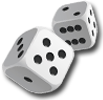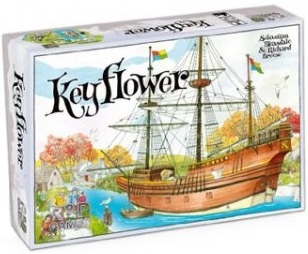



play board games
Board game reviews, strategy tips & session reports
Keyflower Board Game Review
 Stats:
Stats:
No. of players: 2-6
Amount of time to play: 90-120 min
Age requirements: 12+
Set-up time: 5-10 minutes
Keyflower is an auction game mixed with civ building, tile laying and worker placement. You arrive in the new world and must build your village and maximize end-game scoring to win this game.
Keyflower Board Game Rules Description:
Keyflower is played over the course of one year that is broken in to four rounds for the four seasons. Each season new tiles will be available to bid on and new boats will deliver more workers and resources. After winter is over you score VPs from your village tiles and gold.
You start the game with eight random workers in three colors, red, blue and yellow. You also get a home tile and some winter tiles that you keep secret. The number of winter tiles you get depends on the number of players. The player with the lowest numbered home tile starts the game. The game starts with the Spring tiles in the center of the table along with the player order tiles and boats.
On your turn you may place one or more worker onto a single location. If you want to add a tile to your village at the end of the season you must win an auction for it. To bid on a tile you place one worker one your side of the tile. If this is the first bid you may use any color worker. However if a worker is already someplace at this tile you must bid in the same color workers and you must beat the previous bid. You can add workers to a tile where you have been outbid or move workers from a losing bid to another tile.
The other place you may put your workers is on top of a tile for production. After Spring this includes tiles in your and other players’ villages. You must still follow the color of previously placed workers but lets you take the action on the tile. If a player has already used this tile you must place one more worker than them. There can be a max of six workers on top of a tile.
Transport and upgrade are special actions that each player has on their home tile. Transporting lets you move resources around your village. Upgrading one of your tiles lets you flip it over. This makes their production actions better and might even be worth VPs. Often upgrading will require resources to on the tiles you are upgrading. So the two actions go hand in hand. You need to transport the resources to the tiles so you can upgrade them. Some tiles also score your VPs for having a particular resources on them.
At the end of each season players take back any workers that did not win bids. Then you collect tiles you won and add them to your village. You also collect any workers that were placed in your village or on top of tiles you won. Boat tiles are not bid on but the player that wins the bidding on the first player tile chooses a boat first. When you get a boat you take the workers and resources from it and put them behind your screen. The player that wins the tile to choose their boat last becomes the first player in the new season.
For winter you may place as many of the tiles you got at the beginning of the game as you like in the center for auction. You must put at least one tile in the center for the winter phase. The turn order tiles are also flipped for winter and when added to your village score you one VP for each adjacent tile.
There are a couple more aspects of the game to mention including skills and green meeples. Skills are needed to upgrade tiles. They arrive on boats and may be gained from tiles too. Green meeples introduce a new worker color. The unique meeples can only be gained through tiles and are a powerful resource when bidding given their rarity.
Once winter ends the game is over. You score VPs for ay upgraded tiles, any tiles that score for having resources on them and any gold you have. The player with the most VPs wins.
Quick Review of Keyflower:
Keyflower is complicated when you first learn it, but the time you invest to learn the game is worth it. It has a unique blend of a few common board game mechanics that creates a fun experience.
The components for this game are very good. The art, tiles and chits are well-made and look great. Once learned the symbols on the tiles are easy to understand. This is a complicated game and the rules are not fantastic. They are not horrible either, but they will take a couple reads to fully digest. You will probably want to look at some gameplay videos on YouTube after reading the rules once. After getting a grasp of things from the videos read the rules again and you should be fine.
The first thing I really like about this game is the way the first meeple on a tile determines the color for that tile for the rest of the season. Workers are resources but their color actually matters. It is very unique and fun.
My next point ties into the last one. The green meeples create a rare resource that can help swing an auction in your favor. Ju st be aware that meeples used to win an auction go into the draw bag. This includes green ones.
Starting with the winter tiles can help form your strategy and is is nice to have that information. It is also helpful to know which winter tiles not to put out in order to keep your opponents fro scoring big points.
The biggest thing I don’t like about the game is the complexity. It is not too bad once you learn the game, but the learning curve is steep. It will take a play or two for most people to figure this game out. So introducing it to new players is tough and they’ll probably lose.
Keyflower is a truly unique experience that blends some fun mechanics into a really fun game. The theme is not super strong, but the game play is super solid. If you like auction games this one is worth getting. And any fan of board games should give this one a try. It’s that good.
Score and synopsis: (Click here for an explanation of these review categories.)
Strategy 5 out of 6
Luck 4 out of 6
Player Interaction 5 out of 6
Replay Value 4 out of 6
Complexity 5 out of 6
Fun 5 out of 6
Overall 5 out of 6

Leave a Reply